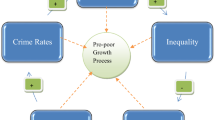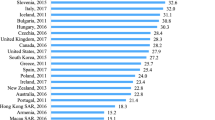Abstract
The aim of this paper is to contribute both theoretically and empirically to the analysis of Inequality of Opportunity over time, providing some significant findings referred to the Spanish case. The analysis is carried out using microdata collected by the European Union Statistics on Income and Living Conditions (EU-SILC), which incorporate a wide variety of personal harmonised variables, allowing comparability with other countries. The availability of this database for the period 2004 and 2010 is particularly relevant for assessing changes over time in the main inequality indices and the contribution of circumstances to inequality of opportunity. We find that the effect of circumstances on income distribution has significantly intensified between the two years. To test the significance of the differences between years we perform bootstrap estimations.








Similar content being viewed by others
Notes
The generalised entropy measures (Cowell 1980; Shorrocks 1984) are given by the expression \(GE\left( \beta \right) = \frac{1}{{\beta \left( {\beta - 1} \right)}}\left[ {\frac{1}{N}\sum\nolimits_{i = 1}^{N} {\left( {\frac{{y_{i} }}{{\bar{y}}}} \right)^{\beta } - 1} } \right]\). They conform a family of measures that satisfy the principles of mean independence, population independence, symmetry, the Pigou–Dalton transfer principle and decomposability. The β parameter represents the weight given to the distances between incomes of different parts of the distribution. When β takes low values, the measure is more sensitive to what occurs at the bottom of the distribution, whereas for high values of the parameter β the measures would be more sensitive to what occurs on the top. The measure proposed (MLD) entails β = 0.
The lack of statistical inference in the literature on measurement of income inequality has been pointed up, among others, by Athanasopoulos and Vahid (2003). These authors use bootstrap methods to analyse the significance of changes in income inequality in Australia.
The equivalence scale used by EU-SILC is: \(e = 1 + 0.5\left( {N_{{14^{ + } }} - 1} \right) + 0.3N_{{13^{ - } }}\) where \(N_{{14^{ + } }}\) is the number of household members with 14 years or more and \(N_{{13^{ - } }}\) the number of members with 13 years or less.
The CDF is not displayed for the variable Gender since no significant differences are observed between the two categories of individuals.
The choice of the variable Regions for the sensitivity analysis is not mere coincidence. We analyse the impact of this variable on the inequality of opportunity, aiming to fill the current literature gap. As it has been already mentioned in Sect. 3, we consider regional inequalities unfair; therefore, to analyse the effect the inclusion of this variable has in inequality of opportunity is a way to emphasise its relevance.
References
Alesina, A., & La Ferrara, E. (2005). Preferences for redistribution in the land of opportunities. Journal of Public Economics, 89(5), 897–931.
Almås, I., Cappelen, A. W., Lind, J. T., Sørensen, E., & Tungodden, B. (2011). Measuring unfair (in)equality. Journal of Public Economics, 95(7–8), 488–499.
Arneson, R. (1989). Equality and equal opportunity for welfare. Philosofical Studies: An International Journal for Philosophy in the Analytic Tradition, 56(1), 77–93.
Athanasopoulos, G., & Vahid, F. (2003). Statistical inference and changes in income inequality in Australia. Economic Record, 79(247), 412–424.
Biewen, M. (2002). Bootstrap inference for inequality, mobility and poverty measurement. Journal of Econometrics, 108, 317–342. www.elsevier.com/locate/econbase.
Björklund, A., Jäntti, M., & Roemer, J. E. (2012). Equality of opportunity and the distribution of long-run income in Sweden. Social Choice and Welfare, 39(2–3), 675–696.
Bossert, W. (1995). Redistribution mechanisms based on individual characteristics. Mathematical Social Sciences, 29(1), 1–17.
Bourguignon, F., Ferreira, F. H. G., & Menéndez, M. (2007). Inequality of Opportunity in Brazil. Review of Income and Wealth, 53(4), 585–618.
Checchi, D., & Peragine, V. (2010). Inequality of opportunity in Italy. The Journal of Economic Inequality, 8(4), 429–450.
Checchi, D., Peragine, V., & Serlenga, L. (2010). Fair and unfair income inequalities in Europe. IZA Discussion Paper, 5025(174), 1–29.
Cogneau, D., & Mesplé-Somps, S. (2008). Inequality of opportunity for income in five countries of Africa. In J. Bishop, & Zheng, B. (eds.), Inequality and opportunity: Papers from the second ECINEQ society meeting (Research on Economic Inequality) (Vol. 16, pp. 99–128). Emeral Group Publishing Limited.
Cohen, G. A. (1989). On the currency of Egalitarian Justice. Ethics, 99(4), 906–944.
Cowell, F. A. (1980). On the structure of additive inequality measures. Review of Economic Studies, 47(3), 521–531.
Devooght, K. (2008). To each the same and to each his own: A proposal to measure responsibility-sensitive income inequality. Economica, 75(298), 280–295.
Dworkin, R. (1981a). What is equality? Part 1: Equality of welfare. Philosophy and Public Affairs, 10(3), 185–246.
Dworkin, R. (1981b). What is equality? Part 2: Equality of resources. Source: Philosophy and Public Affairs, 10(4), 283–345.
Efron, B., & Tibshirani, R. (1986). Bootstrap methods for standard errors, confidence intervals, and other measures of statistical accuracy. Statistical Science, 1(1), 54–77.
Efron, B., & Tibshirani, R. J. (1993). An introduction to the bootstrap. London: Champman & Hall.
Ferreira, F. H. G., & Gignoux, J. (2011). The measurement of inequality of opportunity: Theory and an application to Latin America. Review of Income and Wealth, 57(4), 622–657.
Ferreira, F. H. G. & Peragine, V. (2015). Equality of opportunity: Theory and evidence (No. No. 7217).
Fields, G. S. (2002). Accounting for income inequality and its change: A new method, with application to the distribution of earnings in the United States. In S. W. Polachek (Ed.), Worker well-being and public policy (Research in Labor Economics, Volume 22) (pp. 1–38). Bradford: Emerald Group Publising Limited.
Fleurbaey, M. (1994). On fair compensation. Theory and Decision, 36, 277–307.
Fleurbaey, M., & Peragine, V. (2013). Ex ante versus ex post equality of opportunity. Economica, 80(317), 118–130.
Fleurbaey, M., & Schokkaert, E. (2009). Unfair inequalities in health and health care. Journal of Health Economics, 28(1), 73–90.
Foster, J. E., & Shneyerov, A. A. (2000). Path independent inequality measures. Journal of Economic Theory, 91(2), 199–222.
Gaertnertt, W., & Schwettmannt, L. (2007). Equity, responsibility and the cultural dimension. Economica, 74(74), 627–649.
Hall, P. (1994). Methodology and theory for the bootstrap. In R. F. Engle & D. L. McFadden (Eds.), Handbook of econometrics (Vol. IV, pp. 2341–2381). Amsterdam: Elsevier Science.
Lefranc, A., Pistolesi, N., & Trannoy, A. (2008). Inequality of opportunities vs. inequality of outcomes: Are western societies all alike? Review of Income and Wealth, 54(4), 513–546.
Lefranc, A., Pistolesi, N., & Trannoy, A. (2009). Equality of opportunity and luck: Definitions and testable conditions, with an application to income in France. Journal of Public Economics, 93(11–12), 1189–1207.
Marrero, G. A., & Rodríguez, J. G. (2011). Inequality of Opportunity in the United States: Trends and Decomposition. In J. Bishop (Ed.), Inequality of opportunity: Theory and measurement (Research on Economic Inequality, Volume 19) (Vol. 19, pp. 217–246). Bradford: Emerald Group Publising Limited.
Marrero, G. A., & Rodríguez, J. G. (2012). Inequality of opportunity in Europe. Review of Income and Wealth, 58(4), 597–621.
Mills, J. A., & Zandvakili, S. (1997). Statistical Inference Via Bootstrapping for Measures of Inequality. Journal of Applied Econometrics, 12(2), 133–150. http://www.jstor.org/stable/2284908. Accessed 25 April 2017.
Morduch, J., & Sicular, T. (2002). Rethinking inequality decomposition, with evidence from Rural China author. The Economic Journal, 112(476), 93–106.
Nozick, R. (1974). Anarchy, state, and utopia. New York: Basic Books.
O’Neill, D., Sweetman, O., & Van De Gaer, D. (1999). Equality of Opportunity and Kernel Density Estimation: An Application to Intergenerational Mobility, (May).
Piraino, P. (2015). Intergenerational earnings mobility and equality of opportunity in South Africa. World development, 67(November 2012), 396–405.
Pistolesi, N. (2009). Inequality of opportunity in the land of opportunities, 1968–2001. Journal of Economic Inequality, 7(4), 411–433.
Ramos, X., & Van De Gaer, D. (2016). Approaches to inequality of opportunity: Principles, measures and evidence. Journal of Economic Surveys, 30(5), 855–883.
Rawls, J. (1971). A theory of justice (Vol. 61). Cambridge, MA: Harvard UP.
Roemer, J. E. (1993). A pragmatic theory of responsibility for the egalitarian planner. Philosophy and Public Affairs, 22(2), 146–166.
Roemer, J. E. (1998). Theories of distributive justice. Cambridge, MA: Harvard University Press.
Schokkaert, E., & Devooght, K. (2003). Responsibility-sensitive fair compensation in different cultures. Social Choice and Welfare, 21, 207–242.
Sen, A. (1979). Equality of what? Tanner lectures on human values, 1, 195–220.
Shorrocks, A. F. (1982). Inequality decomposition by factor components. Econometrica, 50(1), 193–211.
Shorrocks, A. F. (1984). Inequality decomposition by population subgroups. Econometrica, 52(6), 1369–1385.
Shorrocks, A. F. (2013). Decomposition procedures for distributional analysis: A unified framework based on the Shapley value. Journal of Economic Inequality, 11(1), 99–126.
Singh, A. (2012). Inequality of opportunity in earnings and consumption expenditure: The case of Indian men. Review of Income and Wealth, 58(1), 79–106.
Suárez-Álvarez, A., & López-Menéndez, A. J. (2016). Inequality of opportunity and income inequality in Spain : An analysis over time (No. 423).
Van de Gaer, D. (1993). Equality of opportunity and investment in human capital. Dissertation Thesis, Katholieke Universiteit Leuven.
Acknowledgements
The authors would like to thank the anonymous referees for their valuable comments which helped to improve the manuscript.
Author information
Authors and Affiliations
Corresponding author
Rights and permissions
About this article
Cite this article
Suárez Álvarez, A., López Menéndez, A.J. Assessing Changes Over Time in Inequality of Opportunity: The Case of Spain. Soc Indic Res 139, 989–1014 (2018). https://doi.org/10.1007/s11205-017-1759-1
Accepted:
Published:
Issue Date:
DOI: https://doi.org/10.1007/s11205-017-1759-1




